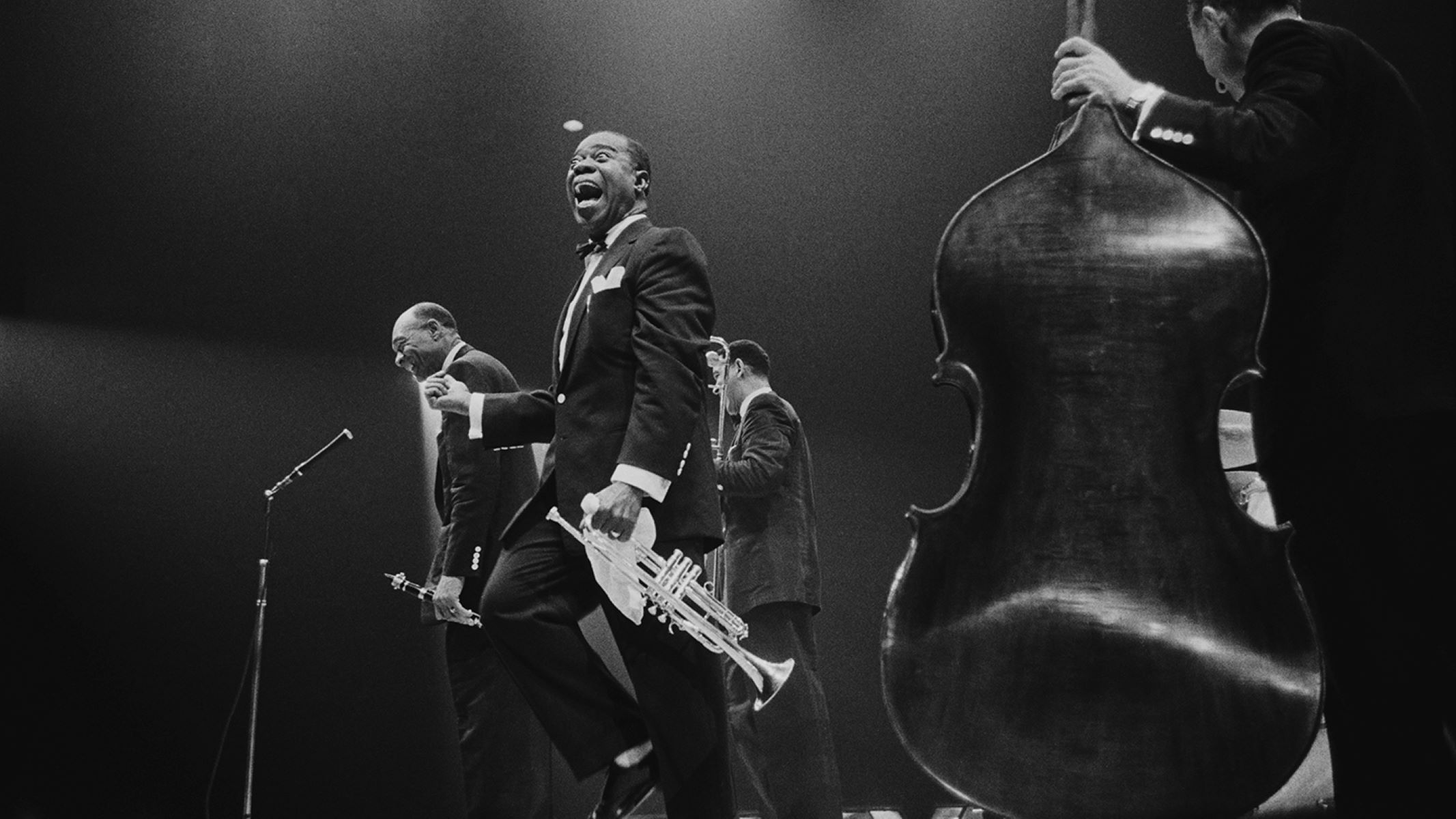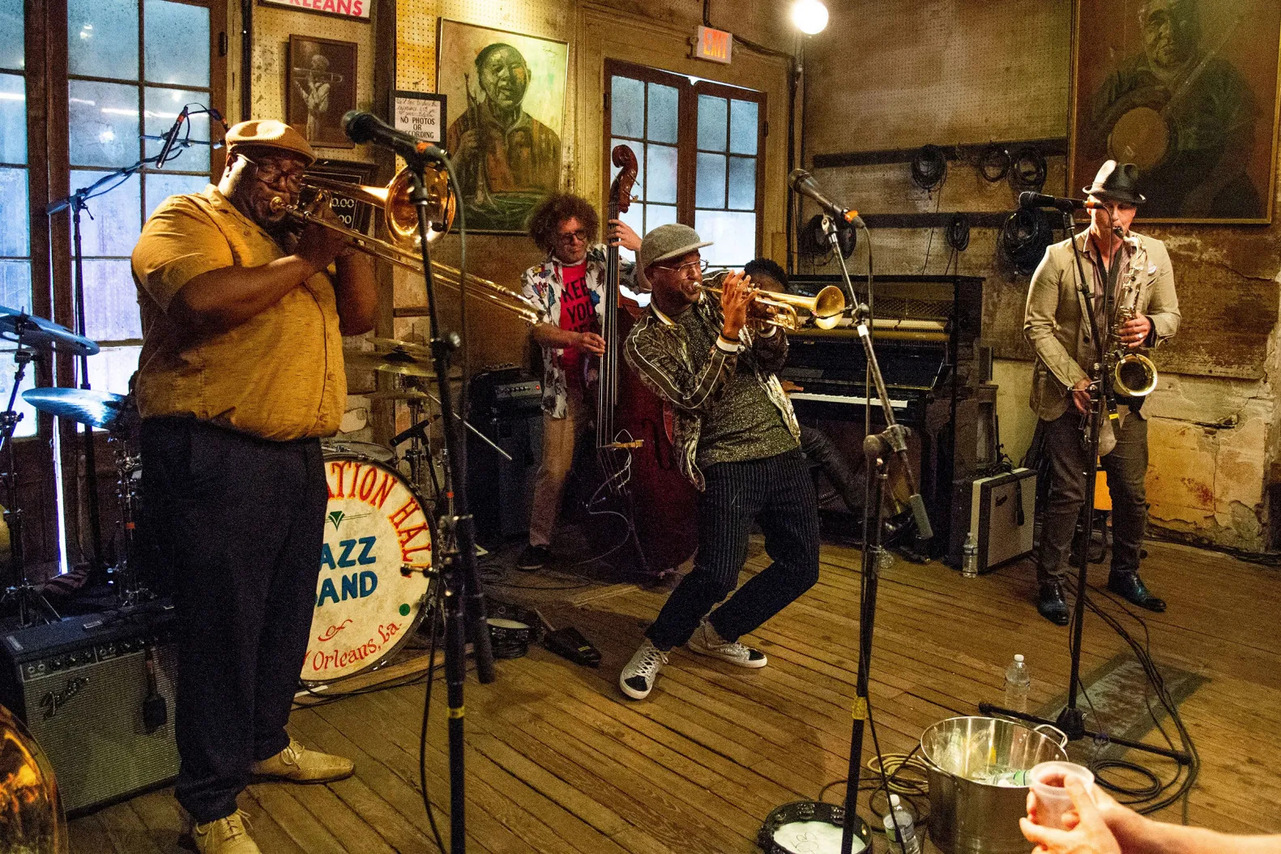

Jazz
What Is Swing In Jazz
Modified: February 24, 2024
Learn about the essence of "swing" in jazz music and its significance in creating rhythmic flow and improvisation. Explore the roots and evolution of jazz, from its early beginnings to its modern interpretations.
(Many of the links in this article redirect to a specific reviewed product. Your purchase of these products through affiliate links helps to generate commission for AudioLover.com, at no extra cost. Learn more)
Table of Contents
Introduction
Jazz is a genre of music that boasts a rich and diverse history, with various styles and sub-genres contributing to its ever-evolving nature. One such style that holds a special place in the hearts of jazz enthusiasts is swing. Swing, also known as swing jazz, emerged during the early 1930s and became immensely popular during the swing era, which lasted until the late 1940s.
Swing music has a unique rhythmic quality and infectious energy that sets it apart from other jazz styles. It has the power to make audiences tap their feet, sway their bodies, and get lost in the mesmerizing melodies and improvisations. But what exactly is swing in jazz, and what makes it so special?
At its core, swing refers to a specific rhythmic feel and groove that permeates through the music, primarily driven by the interaction between the rhythm section and the melody instruments. It is characterized by its lively and propulsive rhythm, where the beats are subtly emphasized to create a distinct swinging feel. Swing not only refers to the rhythmic aspect of jazz but also represents a broader cultural movement that had a significant impact on society during its heyday.
During the swing era, dance halls were filled with people swinging and swaying to the infectious sounds of artists such as Benny Goodman, Count Basie, and Duke Ellington. It was a time when the swinging lifestyle was in vogue, epitomized by the famous Harlem dance halls and the roaring energy of the Savoy Ballroom in New York City.
Swing became the soundtrack to the lives of those who embraced the carefree, exuberant nature of the era. Its popularity spread like wildfire, not only among African American communities but also to mainstream audiences, transcending racial and social boundaries. The swing era symbolized a time of unity, joy, and celebration, where people of different backgrounds came together to enjoy the thrill of the music and dance.
Definition of Swing
Swing, in the context of jazz, can be defined as a rhythmic feel characterized by a forward momentum, syncopated rhythms, and a distinctive sense of groove. It is a musical style that emphasizes the off-beat or “up” beats, creating a swinging sensation that propels the music forward.
The term “swing” originated from the African American vernacular, where it was used to describe the feeling of rhythmic propulsion and momentum. In jazz, swing refers to the collective rhythmic interaction between the musicians, creating a sense of cohesion and synchronization.
Swing can be best understood by listening to the interplay between the rhythm section and the melody instruments. The rhythm section, typically consisting of drums, bass, and piano or guitar, establishes the underlying pulse or beat, while the melody instruments, such as saxophone, trumpet, or trombone, embellish the rhythm with improvised melodies and solos.
One of the defining characteristics of swing is the concept of “swing eighth notes.” In swing rhythm, the eighth notes are not played evenly but are instead divided into a long-short pattern. The long note falls on the beat, while the short note is played slightly before the beat, adding a syncopated and swinging feel to the music.
Swing can be felt in various tempos, from slow and languid to fast and energetic. Each tempo has its unique swinging feel, but regardless of the speed, swing music always possesses a pulsating groove that compels listeners to move and dance.
It’s important to note that swing is not limited to jazz alone. The swinging feel can be found in other genres such as blues, big band, and even rock and roll. However, it is in jazz where swing is most prominently featured, as it became a defining characteristic of the genre during the swing era.
Overall, swing is not just a technical aspect of jazz music, but a cultural phenomenon that captured the hearts and souls of music lovers around the world. It is a rhythmic language that has the power to bring people together, ignite their passion for music, and create a sense of joy and harmony.
Origins of Swing in Jazz
The origins of swing in jazz can be traced back to the early 1920s with the rise of big bands and the evolution of jazz from its New Orleans roots. As jazz started to gain popularity and expand beyond its traditional Dixieland and New Orleans styles, musicians began experimenting with new approaches to rhythm and improvisation.
One of the key figures credited with laying the groundwork for swing is Louis Armstrong. His innovative trumpet playing and unique sense of rhythm greatly influenced the development of swing music. Armstrong’s recordings with his Hot Five and Hot Seven bands showcased a rhythmic drive and interplay that would become foundational to the swing style.
However, it was during the swing era, which began in the 1930s, that swing music fully blossomed. The economic and cultural climate of the time, coupled with advancements in recording technology, provided the perfect platform for the growth and popularity of big bands playing swing jazz.
Big bands, led by bandleaders such as Duke Ellington, Count Basie, Benny Goodman, and Glenn Miller, became synonymous with the swing era. These large ensembles, often consisting of fifteen or more musicians, allowed for intricate arrangements, dynamic solos, and a powerful rhythmic drive that defined the swing sound.
The swing era also saw the emergence of influential jazz arrangers, such as Fletcher Henderson and Sy Oliver, who revolutionized big band writing by incorporating intricate harmonies, ensemble riffs, and solo features. These arrangements added depth and complexity to the music while maintaining the contagious rhythm and swing feel.
It’s important to note that while big bands dominated the swing era, smaller groups, known as combos or small ensembles, also played a significant role in the development of swing. Artists like Coleman Hawkins, Benny Carter, and Johnny Hodges showcased their virtuosity and improvisational skills within a smaller group setting, contributing to the diversity and versatility of swing jazz.
The popularity of swing jazz continued to soar until the start of World War II, where social and economic changes, as well as the drafting of many musicians, led to the decline of big bands. The swing era gradually came to an end, but its influence on jazz and popular music remained significant.
Overall, the origins of swing in jazz can be attributed to the evolution of jazz music itself, the experimentation of musicians, and the cultural climate of the swing era. It was a transformative period that propelled jazz into the mainstream and left an indelible mark on the history of music.
Characteristics of Swing in Jazz
Swing jazz is characterized by a distinct set of musical and stylistic features that make it instantly recognizable. From its rhythmic drive to its melodic improvisations, swing possesses a unique blend of elements that define its sound. Here are some key characteristics of swing in jazz:
- Swinging Rhythm: The most recognizable characteristic of swing jazz is its swinging rhythm. Swing is all about the feel and groove created by the rhythmic interaction between the musicians. The beats are subtly emphasized, with a lively and propulsive energy that compels listeners to tap their feet and move to the music.
- Syncopation: Syncopation is an essential element of swing. It refers to the intentional placement of rhythmic accents on weaker beats or unexpected moments in the music. This rhythmic tension adds excitement and unpredictability to the swing feel, creating a dynamic and energetic sound.
- Call and Response: One of the hallmarks of swing jazz is the call and response technique. Musicians engage in a musical conversation, where one instrument or section presents a musical phrase or motif, and another instrument or section responds with a contrasting or complementary phrase. This interaction adds depth and richness to the music.
- Improvization: Improvisation is a central component of jazz, and swing is no exception. Soloists take turns to improvise over the chord progressions, creating unique melodies and variations on the theme. Swing improvisations often incorporate the rhythmic swing feel, with musicians exploring different rhythmic patterns and syncopations in their solos.
- Big Band Arrangements: During the swing era, big bands were at the forefront of swing jazz. These large ensembles featured intricate arrangements that showcased the power and versatility of swing. Brass sections played dynamic melodies and harmonies, while reed sections provided lush and colorful textures. The interplay between sections, as well as the use of ensemble riffs and solos, added complexity and depth to the music.
- Soloists and Section Interaction: In addition to solo improvisations, swing jazz highlights the interaction between soloists and sections. Musicians take turns playing solos, while the rhythm section supports and interacts with the soloist. The rhythm section, consisting of drums, bass, and piano or guitar, provides a solid foundation, creating a rhythmic dialogue with the soloist, enhancing the swinging feel of the music.
- Swing Dance: Swing jazz and swing dancing are intimately intertwined. The energetic and infectious rhythms of swing music provided the perfect backdrop for dancers during the swing era. Swing dance styles, such as the Lindy Hop and the Charleston, mirror the swinging feel and emphasize the joyful, dynamic nature of the music.
These characteristics work together to create the exciting and captivating sound of swing jazz. The swinging rhythm, syncopation, improvisation, and the interplay between soloists and sections all contribute to the vibrancy and timeless appeal of swing in jazz.
Swing Rhythm in Jazz
Swing rhythm is the heartbeat of jazz music. It is the driving force behind the infectious and energetic feel that defines swing jazz. This rhythmic style sets swing apart from other genres and is what makes it so distinctive and captivating.
The foundation of swing rhythm lies in its unique approach to the division of time. In swing jazz, the eighth notes are played with a specific rhythmic pattern known as “long-short.” This means that the first of the two eighth notes is played slightly longer, and the second note is played slightly shorter, creating a subtle syncopation and swinging feel.
This rhythmic pattern is often described as “swung,” as it imbues the music with a buoyant and swinging quality. It gives swing jazz its infectious pulse that compels listeners to move and dance. The swung eighth notes provide a dynamic contrast to the steady beat played by the rhythm section, creating a sense of tension and release.
The swing rhythm is created through the collective effort of the musicians in a jazz ensemble. The rhythm section, which typically includes drums, bass, and piano or guitar, lays down the foundation by establishing the steady pulse and maintaining the groove.
As the melody instruments, such as saxophone, trumpet, or trombone, play their improvised solos or ensemble melodies, they interact with the swing rhythm in their phrasing and note placement. The musicians play off each other, subtly elongating and shortening the duration of notes to achieve the swing feel.
While swing rhythm is often associated with the even eighth notes of the time signature, it can also be found in other rhythmic patterns within swing jazz. Musicians may use syncopated rhythms, dotted rhythms, and triplet subdivisions to further enhance the swinging feel and create rhythmic interest.
Swing rhythm is a crucial element of jazz improvisation. Soloists internalize the swing feel and incorporate it into their melodic ideas and rhythmic phrasing. They navigate the rhythmic space between the pulse and the swung notes, playing with the nuances and subtleties of the swing rhythm to create their unique musical expressions.
Swing rhythm in jazz is not just a mechanical aspect of music; it is an art form in itself. It is the result of the intuitive communication and interaction between musicians, bringing the music to life and captivating audiences with its infectious energy. The swing rhythm is what makes jazz swing, and it continues to thrill and inspire listeners as the heartbeat of this remarkable musical genre.
Role of Swing in Jazz Improvisation
Swing, with its distinct rhythmic feel and groove, plays a vital role in jazz improvisation. It serves as the foundation upon which jazz musicians build their melodic and rhythmic ideas, enabling them to express their creativity and make their mark in the world of jazz.
Swing rhythm provides a flexible and elastic framework for improvisation. It allows musicians to stretch and reinterpret the melodic lines, experimenting with rhythm, phrasing, and note choices. The swung eighth notes create a rhythmic space where musicians can explore and play with different subdivisions and syncopations.
When improvising in swing jazz, musicians internalize the swing rhythm and incorporate it into their improvisational vocabulary. They intuitively navigate the intricate interplay between the swung notes and the underlying beat, creating momentum and excitement within their solos.
One characteristic of swing jazz improvisation is the use of rhythmic syncopation. Musicians accentuate off-beats and play with rhythmic surprises, injecting their solos with energy and drive. The swinging feel allows them to create tension and release by playing against the established pulse, creating a sense of anticipation and capturing the listener’s attention.
Swing also influences the phrasing and articulation in jazz improvisation. Musicians use techniques such as bending, sliding, and scooping notes, all of which contribute to the swinging feel. The rhythmic elasticity of swing allows for expressive and dynamic phrasing, giving improvisations a distinctive and engaging quality.
Additionally, swing rhythm fosters communication and interaction between musicians during improvisation. It provides a common rhythmic language that facilitates musical dialogue. Musicians listen to and respond to each other’s improvisations, taking turns in exchanging musical ideas, and building upon them. This interplay adds depth and richness to the improvisational experience, creating a cohesive and engaging musical conversation.
Swing also influences the harmonic choices made during improvisation. The rhythmic feel of swing allows musicians to explore different chord progressions and melodic ideas, leading to complex and inventive improvisations. The swinging pulse provides a secure foundation for exploring harmonic variations and substitutions, adding color and complexity to the solo lines.
Ultimately, swing in jazz improvisation is about artistic expression and individuality. It encourages musicians to bring their unique voice to the music, infusing their improvisations with the swinging feel that defines jazz. Improvisation in swing jazz is a dynamic and interactive process, where musicians draw upon the rhythmic framework to create captivating and memorable performances.
Famous Swing Jazz Artists
The swing era produced a wealth of talented musicians who became icons of the genre and left an indelible mark on the history of jazz. Their contributions to swing jazz not only showcased their incredible musical prowess but also helped popularize the swinging style and captivate audiences around the globe. Here are just a few of the famous swing jazz artists:
- Benny Goodman: Known as the “King of Swing,” Benny Goodman was a clarinetist and bandleader who played a pivotal role in popularizing swing music. His performances, such as the historic 1938 Carnegie Hall concert, brought swing jazz to mainstream audiences and made him a household name.
- Duke Ellington: Duke Ellington was a legendary composer, pianist, and bandleader who led one of the most influential swing orchestras. His compositions, such as “Take the ‘A’ Train” and “Mood Indigo,” were innovative and showcased his mastery of orchestration, harmonic complexity, and improvisation.
- Count Basie: Count Basie was a renowned pianist, bandleader, and composer known for his distinctive style and tight-knit swing rhythm section. His Count Basie Orchestra was celebrated for its infectious swing and featured exceptional soloists, including tenor saxophonist Lester Young.
- Louis Armstrong: Louis Armstrong, also known as “Satchmo,” was a trumpet virtuoso and singer who bridged the gap between early jazz and swing. His influence on swing is immense, as his innovative playing and charismatic stage presence captivated audiences and inspired generations of musicians.
- Ella Fitzgerald: Often referred to as the “First Lady of Swing,” Ella Fitzgerald was an exceptional jazz vocalist known for her impeccable technique, scat singing abilities, and interpretation of swing-era standards. Her collaborations with big band leaders like Chick Webb and Duke Ellington are legendary.
- Artie Shaw: Artie Shaw was a clarinetist, composer, and bandleader who achieved great success during the swing era. Known for his technical proficiency and innovative arrangements, Shaw’s band was highly regarded for its tight ensemble playing and memorable recordings, including “Begin the Beguine.”
- Lionel Hampton: Lionel Hampton was a renowned vibraphonist, drummer, and bandleader known for his energetic performances and virtuosic improvisation. He became an influential figure in incorporating the vibraphone into swing jazz, and his big band recordings were an exciting blend of swing and blues.
These are just a few of the countless artists who helped define swing jazz and made significant contributions to the genre. Their artistry, innovation, and enduring musical legacies continue to inspire musicians and jazz lovers worldwide.
Influence and Legacy of Swing in Jazz
The influence and legacy of swing in jazz cannot be overstated. Swing jazz not only captivated audiences during the swing era but also left an everlasting impact on the evolution of jazz and popular music. Here are some of the ways swing has shaped the world of jazz:
Expansion of Jazz Audience: Swing jazz played a significant role in expanding the audience for jazz music. Its infectious rhythms and energetic performances appealed to a broader demographic, transcending racial and social barriers. Swing brought jazz into the mainstream, making it accessible to a wider audience and establishing jazz as a prominent genre of music.
Development of Big Band Arrangements: The swing era saw the rise of big bands, with their intricate arrangements and powerful performances. Bandleaders like Duke Ellington, Count Basie, and Benny Goodman revolutionized the art of arranging for large ensembles. Their innovative compositions, precise orchestration, and dynamic use of sections set new standards for big band jazz, influencing generations of arrangers and composers.
Influence on Other Genres and Styles: Swing jazz influenced not only jazz itself but also various other genres and styles of music. Elements of swing can be found in the blues, rock and roll, R&B, and even early forms of bebop. The swinging feel, syncopated rhythms, and call-and-response patterns of swing jazz have left an indelible mark on the broader landscape of popular music.
Techniques of Improvisation: Swing jazz brought improvisation to the forefront of jazz music. Musicians during the swing era, such as Charlie Parker, Dizzy Gillespie, and Thelonious Monk, began pushing the boundaries of jazz improvisation, incorporating complex harmonies and bebop vocabulary while still maintaining the swinging pulse. Many of the techniques developed during this time are still used by modern jazz musicians today.
Cultural Impact: The swing era had a profound cultural impact, particularly in African American communities. It provided a platform for social expression and served as a unifying force during a time of racial segregation and discrimination. Swing music and dance played a significant role in breaking down barriers and fostering a sense of unity, joy, and liberation.
The legacy of swing jazz continues to be celebrated through the preservation and performance of swing music by contemporary musicians and dedicated enthusiasts. Swing festivals and dance events still draw large crowds and keep the swinging spirit alive. Swing remains a cherished part of jazz history, showcasing the vibrancy, creativity, and enduring appeal of this iconic genre.
Conclusion
Swing in jazz represents a vibrant and significant chapter in the history of music. It is characterized by its distinctive rhythmic feel, infectious energy, and a legacy that continues to resonate with audiences of all generations. The rise of swing jazz during the swing era brought jazz into the mainstream, expanding its audience and influencing the development of other genres.
The swinging pulse and syncopated rhythms of swing jazz created an engaging and dynamic musical experience. It provided a platform for musicians to showcase their virtuosity and creativity through improvisation, resulting in timeless recordings and legendary performances. The contributions of swing jazz artists such as Benny Goodman, Duke Ellington, and Ella Fitzgerald laid the foundation for future generations of musicians to build upon.
Swing jazz also had a profound cultural influence during a time of great social change. It crossed racial and social boundaries, fostering unity and joy through music and dance. The swing era became a symbol of liberation and a celebration of the human spirit, leaving an enduring impact on the social fabric of society.
The legacy of swing in jazz continues to inspire and influence musicians today. Its rhythmic concepts, sophisticated arrangements, and improvisational techniques have become fundamental aspects of jazz music. Swing jazz paved the way for the evolution of other jazz styles, such as bebop, cool jazz, and fusion, while its influence can still be found in modern popular music.
As we look back on the history of jazz, swing stands as a testament to the power of music to transcend barriers and bring people together. Its infectious rhythms and joyous spirit continue to resonate, reminding us of the timeless appeal of swing in jazz. Whether it’s through the iconic recordings of the swing era or the energetic performances of contemporary swing bands, the swinging feel of this genre will forever hold a special place in the hearts of music lovers around the world.











